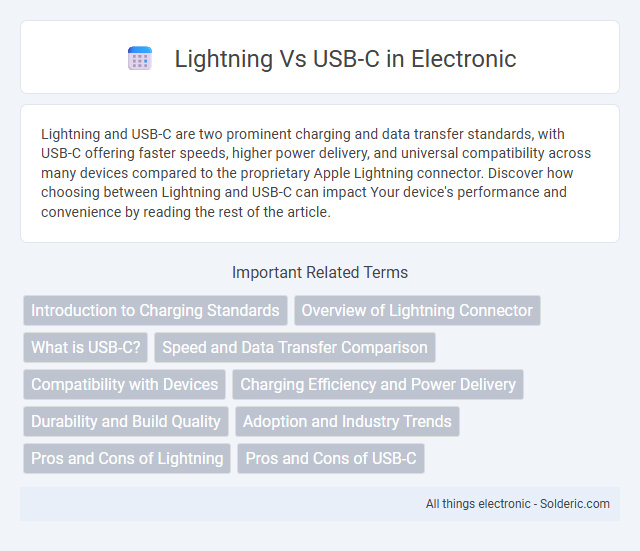Lightning and USB-C are two prominent charging and data transfer standards, with USB-C offering faster speeds, higher power delivery, and universal compatibility across many devices compared to the proprietary Apple Lightning connector. Discover how choosing between Lightning and USB-C can impact Your device's performance and convenience by reading the rest of the article.
Comparison Table
| Feature | Lightning | USB-C |
|---|---|---|
| Introduced | 2012 by Apple | 2014 by USB Implementers Forum |
| Connector Type | 8-pin proprietary connector | 24-pin reversible connector |
| Compatibility | Apple devices (iPhone, iPad, iPod) | Wide range: Android, laptops, tablets, gaming devices |
| Data Transfer Speed | Up to 480 Mbps (USB 2.0) | Up to 40 Gbps (USB4/Thunderbolt 3) |
| Power Delivery | Up to 12W (some models up to 20W) | Up to 100W with USB Power Delivery (USB PD) |
| Reversibility | Yes | Yes |
| Adoption | Exclusive to Apple ecosystem | Industry standard, cross-platform |
| Durability | Moderate, prone to wear | High, robust design |
| Future Outlook | Being phased out in favor of USB-C | Universal standard, growing adoption |
Introduction to Charging Standards
Lightning and USB-C are two prominent charging standards used primarily for mobile devices and accessories. USB-C offers faster data transfer speeds and higher power delivery, enabling quicker charging times compared to Lightning connectors. Your choice between Lightning and USB-C can impact device compatibility, charging efficiency, and accessory availability.
Overview of Lightning Connector
The Lightning connector, introduced by Apple in 2012, is an 8-pin proprietary interface designed for seamless data transfer and charging across iPhones, iPads, and iPods. It features a reversible design that allows easy plug-in from either side, optimizing user convenience compared to older USB standards. Despite its compact size and durability, the Lightning connector is gradually being replaced by the more universal USB-C standard, which offers higher data transfer rates and broader device compatibility.
What is USB-C?
USB-C is a universal connector standard designed for both data transfer and power delivery, characterized by its reversible, compact, and symmetrical design. It supports various protocols such as USB 3.1, Thunderbolt 3, and DisplayPort, enabling faster data speeds up to 40 Gbps and power output up to 100 watts. USB-C has become the preferred interface for modern smartphones, laptops, tablets, and peripherals due to its versatility and widespread adoption.
Speed and Data Transfer Comparison
USB-C offers significantly faster data transfer speeds compared to Lightning, supporting up to 40Gbps with Thunderbolt 3 or 4 protocols, while Lightning maxes out at USB 2.0 speeds of 480Mbps. For tasks requiring rapid file transfers, such as 4K video editing or large media libraries, USB-C provides a clear advantage. Your devices will benefit from USB-C's superior performance for high-speed connectivity and efficient data handling.
Compatibility with Devices
Lightning connectors are primarily compatible with Apple devices such as iPhones, iPads, and certain accessories, offering a proprietary charging and data transfer solution. USB-C ports are widely adopted across various brands, including Android smartphones, laptops, tablets, and peripherals, enabling broader cross-device compatibility. The universal nature of USB-C facilitates seamless use with multiple device ecosystems, reducing the need for multiple cables and adapters.
Charging Efficiency and Power Delivery
USB-C supports higher charging efficiency and power delivery, offering up to 100W with USB Power Delivery (USB PD) protocols, making it ideal for fast-charging smartphones, tablets, and laptops. Lightning, primarily designed by Apple, provides lower power delivery, generally maxing out around 18W, which results in slower charging speeds compared to USB-C. To maximize your device's charging efficiency and speed, opting for USB-C compatible chargers and cables offers a significant advantage in power delivery capabilities.
Durability and Build Quality
Lightning connectors feature a robust design with a solid metal casing, providing excellent durability and resistance to daily wear and tear. USB-C connectors are engineered with reinforced, symmetrical plugs that support frequent insertion and removal, enhancing their lifespan during heavy use. You can expect USB-C to offer slightly better build quality in terms of durability due to its universal design and widespread adoption across various devices.
Adoption and Industry Trends
USB-C has rapidly become the dominant charging and data transfer standard due to widespread adoption by major manufacturers like Apple, Samsung, and Google, supported by the USB Implementers Forum's unified protocol. Lightning remains primarily used in Apple's iPhone ecosystem but faces decreasing relevance as Apple transitions newer devices to USB-C in response to regulatory pressure and consumer demand. Your choice between Lightning and USB-C cables reflects broader industry trends favoring USB-C's universal compatibility, faster charging, and data transfer speeds.
Pros and Cons of Lightning
Lightning connectors offer compact design and strong durability, supporting fast charging and high-quality audio transmission, which benefits your device's convenience and performance. However, Lightning cables are typically more expensive and less widely compatible compared to USB-C, limiting ease of use across different devices. The proprietary nature of Lightning restricts accessory options, making USB-C a more versatile choice for many users.
Pros and Cons of USB-C
USB-C offers a versatile and fast charging solution compatible with a wide range of devices, supporting high data transfer rates up to 40Gbps via Thunderbolt 3 and delivering power up to 100W for efficient charging. Its reversible connector design enhances user convenience, but compatibility can vary across devices, requiring adapters for some older or non-USB-C peripherals. Your experience might improve with USB-C's universal adoption, yet potential confusion over cable types and standards may pose challenges.
Lightning vs USB-C Infographic

 solderic.com
solderic.com